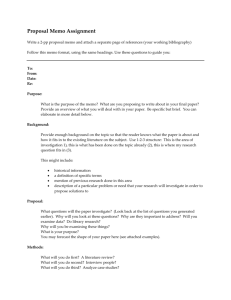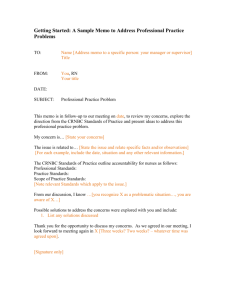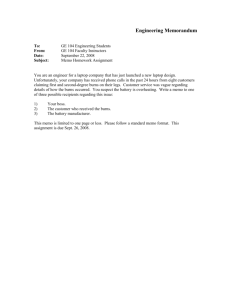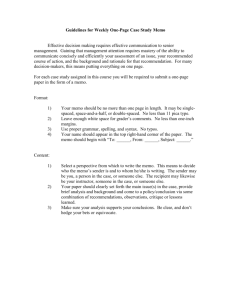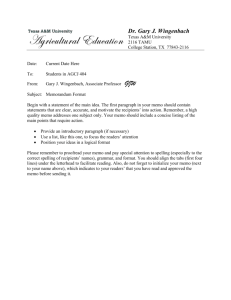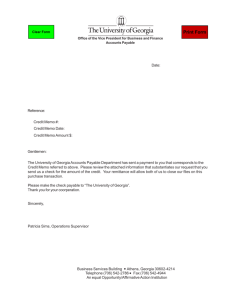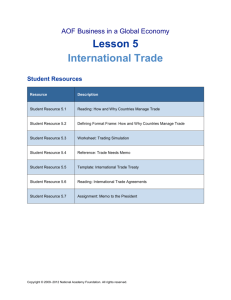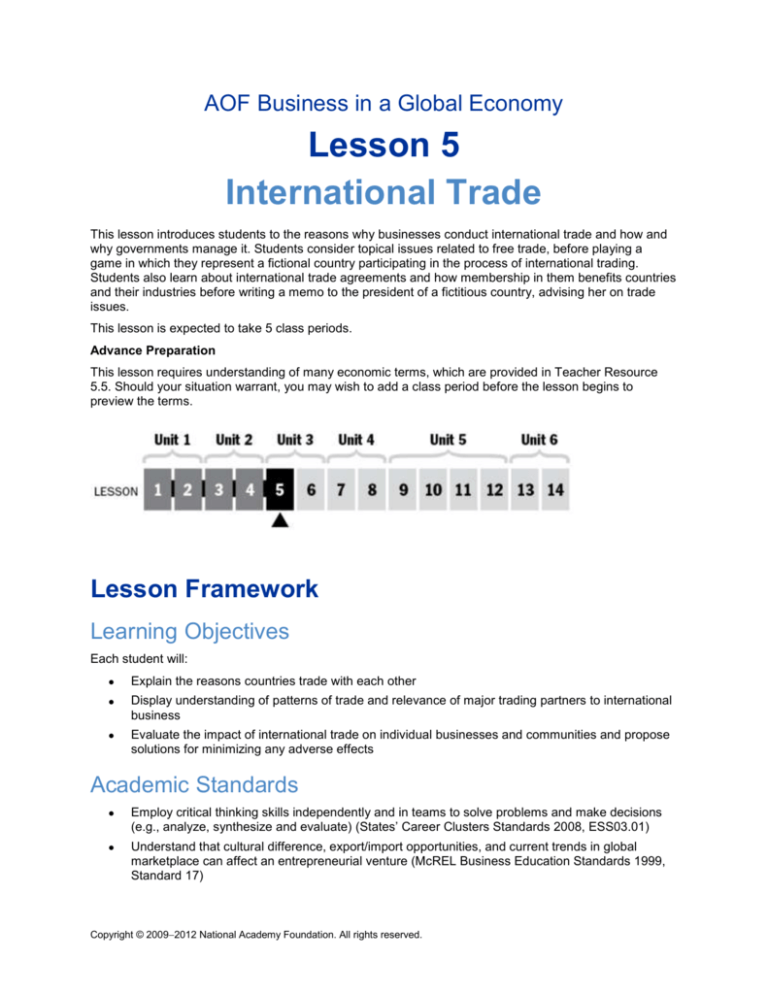
AOF Business in a Global Economy
Lesson 5
International Trade
This lesson introduces students to the reasons why businesses conduct international trade and how and
why governments manage it. Students consider topical issues related to free trade, before playing a
game in which they represent a fictional country participating in the process of international trading.
Students also learn about international trade agreements and how membership in them benefits countries
and their industries before writing a memo to the president of a fictitious country, advising her on trade
issues.
This lesson is expected to take 5 class periods.
Advance Preparation
This lesson requires understanding of many economic terms, which are provided in Teacher Resource
5.5. Should your situation warrant, you may wish to add a class period before the lesson begins to
preview the terms.
Lesson Framework
Learning Objectives
Each student will:
Explain the reasons countries trade with each other
Display understanding of patterns of trade and relevance of major trading partners to international
business
Evaluate the impact of international trade on individual businesses and communities and propose
solutions for minimizing any adverse effects
Academic Standards
Employ critical thinking skills independently and in teams to solve problems and make decisions
(e.g., analyze, synthesize and evaluate) (States’ Career Clusters Standards 2008, ESS03.01)
Understand that cultural difference, export/import opportunities, and current trends in global
marketplace can affect an entrepreneurial venture (McREL Business Education Standards 1999,
Standard 17)
Copyright © 20092012 National Academy Foundation. All rights reserved.
AOF Business in a Global Economy
Lesson 5 International Trade
Understand significant aspects of international business and trade and the opportunities they
create at the local, state, national, and international level (McREL Business Education Standards
1999, Standard 31)
Understand the social, cultural, political, legal, and economic factors and issues that shape and
impact the international business environment (McREL Business Education Standards 1999,
Standard 32)
Understand the obligations of business to the government and the community (McREL Business
Education Standards 1999, Standard 33)
Students will understand that productive resources are limited, therefore, people can not have all
the goods and services they want; as a result, they must choose some things and give up others.
(NCEE National Standards 1997 Standard 1)
Assessment
Assessment Product
Means of Assessment
Memo to a president recommending
international trade decisions (Student Resource
5.7)
Assessment Criteria: Memo to the President
(Teacher Resource 5.4)
Prerequisites
Understanding of why market economies foster trade
Understanding of the dynamics of supply and demand
Understanding of how to write a professional memo
Instructional Materials
Teacher Resources
Teacher Resource 5.1, List: International Trade Statements
Teacher Resource 5.2, Presentation: How and Why Countries Manage Trade (separate
PowerPoint file)
Teacher Resource 5.3, List: Countries and Factors of Production
Teacher Resource 5.4, Assessment Criteria: Memo to the President
Teacher Resource 5.5, Key Vocabulary: International Trade
Teacher Resource 5.6, Bibliography: International Trade
Student Resources
Student Resource 5.1, Reading: How and Why Countries Manage Trade
Student Resource 5.2, Defining Format Frame: How and Why Countries Manage Trade
Student Resource 5.3, Worksheet: Trading Simulation
Student Resource 5.4, Reference: Trade Needs Memo
Copyright © 20092012 National Academy Foundation. All rights reserved.
-2-
AOF Business in a Global Economy
Lesson 5 International Trade
Student Resource 5.5, Template: International Trade Treaty
Student Resource 5.6, Reading: International Trade Agreements
Student Resource 5.7, Assignment: Memo to the President
Equipment and Supplies
Blackboard, whiteboard, or flip chart
LCD projector and computer for PowerPoint presentation
Ample space for trading game
Lesson Steps
Step
Min.
Activity
CLASS PERIOD 1
1
25
Vote With Your Feet: Where Do You Stand on International Trade?
This activity allows students to consider many statements related to international trade
and form opinions about them.
Explain to students that you will be reading a list of statements related to international
trade and that they will be considering how they feel about each. Explain to students
that they will be giving each statement a numerical vote ranging from 1 to 5. 5
represents strong agreement with, 1 strong disagreement with, and 3 a neutral feeling
about.
Read aloud, one at a time, the statements on Teacher Resource 5.1, List: International
Trade Statements. After you read each statement, ask students to think about how they
feel about it, make their numerical vote on it, and share their vote with a partner.
After students vote on each statement, ask them to share with their partners why they
voted as they did. Encourage students to share their votes with the class, pointing out
that international trade is a multi-faceted issue, and what may be a pro to one person
could be a con to another. Ask them to think about whether they looked at the
statement from the home or host country perspective, and how this perspective
influenced their vote.
Continue reading the statements on the list one by one, asking students to vote and
share their reasoning with their partners.
Finally, direct students to make one comprehensive vote by placing themselves on a
continuum in response to this prompt: “International trade improves the state of the
world,” with 5 representing “strongly in agreement with the statement” and 1
representing “strongly opposed to the statement.” Remind them that this vote should be
a compilation of all their prior votes. Discuss the challenges, if any, they faced making
the comprehensive vote about international trade, and which statements most strongly
influenced them. Explain that despite some downsides, many firms find they have many
compelling reasons to trade; and that most governments find it is in a country’s best
interest to encourage international trade. Explain that, nevertheless, governments also
manage the way international trade works, at least to some degree. At a minimum,
governments are responsible for negotiating and administering international trade
agreements that define the agreed rules for trading. Students will learn how and why
Copyright © 20092012 National Academy Foundation. All rights reserved.
-3-
AOF Business in a Global Economy
Lesson 5 International Trade
Step
Min.
Activity
countries manage trade in the next activity.
2
25
Presentation: How and Why Countries Manage Trade
The objective of this activity is to provide students with a more in-depth understanding
of the reasons countries manage trade. It will also get them thinking about
specialization and trade balance.
Before class begins, prepare notes to guide class discussion using Teacher Resource
5.2, Presentation Notes: How and Why Countries Manage Trade.
Present Teacher Resource 5.2, Presentation: How and Why Countries Manage Trade
(separate PowerPoint presentation), to the class. There are various options for using
this presentation with your students, depending upon your situation and preferences:
1. This teacher resource can be presented as a PowerPoint slideshow using an LCD
projector. To activate the slideshow, click View and select Slide Show. Every time
you click the mouse, the next slide will appear.
Use the presentation notes you prepared prior to class to introduce the content of
each slide and encourage class discussion. Note that this activity is not a lecture
but rather a participatory experience for the students; the presentation is interactive
and designed to provoke inquiry.
2. This complete presentation is also included for students to use as Student
Resource 5.1, Reading: How and Why Countries Manage Trade. You can have
them read it and answer the discussion questions in their notebooks, and then
come together as a class to share ideas for the answers.
Instruct students to complete the blank spaces on Student Resource 5.2, Defining
Format Frame: How and Why Countries Manage Trade, with a partner based on the
presentation. Then have students share their answers as a class, and direct them to
add any additional information to their frame that they did not come up with. If you wish,
you can mark the worksheets for credit/no credit.
Explain to students that now that they understand more about the benefits of importing
and exporting and how governments manage trade, they will learn about how countries
negotiate trade agreements in the next activity.
CLASS PERIOD 2
3
50
Simulation Preparation: Negotiating Trade Agreements
The objective of this activity is to teach students how countries’ trade policies influence
what goods and services are traded internationally. It also prepares students, acting as
representatives of a government, to help decide which other country it would be best to
enter a bilateral trade agreement with. This activity focuses on the following career
skills:
Being open and responsive to new and diverse perspectives
Demonstrating teamwork and cooperation
Break students into six groups of equal number. Explain that each of these groups
represents a country looking to improve its national economy by entering into a bilateral
trade agreement with one of the other five countries. These six countries have been
Copyright © 20092012 National Academy Foundation. All rights reserved.
-4-
AOF Business in a Global Economy
Lesson 5 International Trade
Step
Min.
Activity
invited to send delegates to an international trade conference, which will occur in the
next class period.
Today, the delegates will be meeting to review their factors of production, assess their
needs, determine which goods and services to trade for their country’s maximum
benefit, and prioritize which countries they would like to trade with.
Pass out Teacher Resource 5.3, List: Countries and Factors of Production. Assign each
group a country and ask students carefully review their country’s data before directing
them to fill out the information on Student Resource 5.3, Worksheet: Trading
Simulation. Circulate among groups to help them decide which resources they should
consider trading, why, for what, and with whom.
Explain that the more carefully they consider the trade advantages and disadvantages
of their countries, the better choices they will make for potential trade agreements. Now
that they have pinpointed their needs, students will have a chance to make a bilateral
trade agreement and sign a treaty about it in the next class period.
Let students know that they will have a few minutes at the start of the next class period
to finalize their group’s terms for the International Trading Conference, so if they
haven’t come to consensus, they should complete Student Resource 5.3 as homework.
CLASS PERIOD 3
4
50
Simulation: Negotiating Trade Agreements
This activity will give students the opportunity to act as delegates for their countries,
undergoing the process of making trade agreements. It focuses on the following career
skill:
Working effectively in a climate of ambiguity and changing priorities
Give groups 10 minutes or so to come to consensus on Student Resource 5.3.
Circulate around the class and answer questions as needed. When students are ready,
ask country groups to assemble and read Student Resource 5.4, Reference: Trade
Needs Memo. Explain that you expect students to follow the tips and will be expecting
at least one signed treaty per group. Answer any questions students and make all
groups have identified their first, second, and third choice country for trade.
Ask students to take out a copy of Student Resource 5.5, Template: International Trade
Treaty and read it aloud. Explain that before students fill out the template, they must
come to mutual agreement about all the sections (left blank) on the treaty. Remind
them that the countries participating in the trade treaty must find it to be mutually
beneficial. Read through the Negotiating Tips section of Student Resource 5.4,
Reference: Trade Needs Memo with students. Solicit and answer questions, and then
call time to begin the negotiations. Allow each group enough time to negotiate and sign
a treaty.
Randomly choose one country to begin and ask its delegates to identify their first
choice. For instance, Mooland may select Birdland as its first choice. Ask Birdland if it is
interested in negotiating a trade agreement with Mooland; if the answer is “yes,” invite
the two countries’ delegates to meet and begin negotiations. If it is “no,” move on to the
second choice. Continue the process until all six countries have trading partners.
Tell students that they must have one signed treaty by the end of the period, and if they
have time left over after successfully completing their first agreement, they can improve
Copyright © 20092012 National Academy Foundation. All rights reserved.
-5-
AOF Business in a Global Economy
Lesson 5 International Trade
Step
Min.
Activity
their country’s lot by pursuing a second.
Circulate among the negotiators, observing the process, assisting as necessary, and
reminding students of the negotiating tips. When 20 minutes are left, make an
announcement that students should be working on hammering out the final details of
their treaties so that they will have time to fill out and sign the template.
Congratulate students on their successful negotiations and point out that they reached
bilateral trade agreements much more quickly than real countries do; however, they
had relatively few issues to focus on, unlike real countries. Explain that most trade
agreements are multilateral rather than bilateral, which increases the complexity of
negotiations considerably.
Collect treaties at the end of the period, and tell students that they will have a chance to
reflect on the negotiation process in the next activity. You may wish to mark the treaties
credit/no credit.
CLASS PERIOD 4
5
15
Reflection: Trading Simulation
This activity allows students the opportunity to analyze their performance in the Trading
Simulation.
Ask students to respond to the following questions in their notebooks:
How do you feel the results of the treaty (or treaties) your group signed? Why do
you feel that way?
What surprised you about the negotiation process? What did you learn from the
experience?
What would you choose to do differently if you were to play the trading game
again? Why?
You may wish to mark the notebook entry for credit/no credit. Explain that countries
often join international trade agreements or organizations such as NAFTA (the North
American Free Trade Agreement) to help their firms gain better access to other
countries’ markets in order to become more efficient producers and traders, and to
benefit consumers through the increased choice and lower prices that can result from
competitive imports. Let students know that they will learn more about these
agreements and organizations in the next activity.
6
35
Reading: International Trade Organizations
This reading gives students the background information they need to understand why
international trade agreements and organizations exist and how they help countries
reach their trading goals.
For the pre-reading activity, write just the acronyms of these trade agreements on the
blackboard, whiteboard, or flip chart (the full names are provided for your reference):
WTO (World Trade Organization)
NAFTA (North American Free Trade Agreement)
PICTA (Pacific Island Countries Trade Agreement)
Copyright © 20092012 National Academy Foundation. All rights reserved.
-6-
AOF Business in a Global Economy
Lesson 5 International Trade
Step
Min.
Activity
AFTZ (African Free Trade Zone)
Ask students to identify, or even guess at, what these acronyms stand for and share
what they know about them. Reveal what the acronyms stand for, and ask students to
consider why they suppose so many trade agreements are regional. Why might the
WTO be different? Explain that countries often join international trade agreements or
organizations such as NAFTA to help their firms gain better access to other countries’
markets, in order to become more efficient producers and traders, and trading across
long distances tends to reduce efficiency.
Refer students to Student Resource 5.6, Reading: International Trade Agreements, and
ask them to highlight, underline, or record in their notebooks the benefits nations seek
to obtain for their industries and consumers by joining trade agreements. Once they
complete the reading, ask students to partner up and compare the benefits they
identified, adding any of the benefits their partner identified to their own lists for the
post-reading activity. Explain that they will need these lists for the next activity, writing a
memo to their fictional country’s president, advising her on trade policy.
CLASS PERIOD 5
7
40
Writing: Memo to the President
This activity allows students to show understanding of why international trade can help
a country’s economy by writing a memo to a president of a fictional country who is
being pressured to enact protectionist measures in the face of a weakening domestic
economy.
Ask students to read Student Resource 5.7, Assignment: Memo to the President.
Review the content of the memo and clarify it as necessary. Ask students to begin by
individually responding in writing to the questions the president has asked. Be sure to
point out the criteria the memos will be assessed on so that students understand what
is required of them.
Remind students that the resources from the lesson will help them to address the
questions. Namely, they should think about how the country’s firms could increase their
profits through trade by increasing firms’ exports, creating trading blocs, raising tariffs,
imposing quotas, and so on. They should also consider which of their industries would
face risks because of international trade, and explain why these industries would be at
risk. Circulate and assist students as necessary.
After approximately 25 minutes have elapsed, ask students to partner up and review
and comment on each other’s answers. Direct them to revise their comments according
to the feedback and complete the final draft of the memo to the president for homework.
Assess the memos with Teacher Resource 5.4, Assessment Criteria: Memo to the
President. Let them know they will have a chance to think more about international
trade issues in the final reflective activity.
8
10
Think, Share, Pair: International Trade
This activity allows students to reflect on the many things they learned about
international trade throughout this lesson.
Ask students to think about something that they learned during the lesson that
surprised or upset them and share with a partner. Then solicit responses to discuss as
Copyright © 20092012 National Academy Foundation. All rights reserved.
-7-
AOF Business in a Global Economy
Lesson 5 International Trade
Step
Min.
Activity
a class.
Discuss which issues seem most surprising and upsetting to students and why. Let
them know that in the next lesson, they will learn about another way that money
crosses borders, Foreign Direct Investment.
Extensions
Enrichment
So that students get more experience in trade negotiations, add more time to that activity and ask
that all groups negotiate at least three treaties. Ask them to share what gets harder, and what gets
easier, the more they negotiate.
To further understand the intricacies of trade agreements, assign student groups one major
international agreement to research. Ask students to create posters highlighting the goals and
accomplishments of the agreements and hang the posters around the classroom.
To get more experience in the strategy of international trade, play the trading games on any of
these websites:
o www.miniconomy.com
o
http://nobelprize.org/educational_games/economics/trade/
o
http://www.imf.org/external/np/exr/center/students/trade/index.htm
o
http://www.economicsnetwork.ac.uk/showcase/sloman_game.htm
o
http://desertislandgame.com/
o
http://www.need.org/needpdf/Global%20Trading%20Game.pdf
Cross-Curricular Integration
American History: In order to understand how economic policy affects politics, write a report about
the Smoot-Hawley Tariff Act’s influence on the world economic depression that followed the Great
Crash of 1929; and also on World War II; and what lessons about international economic issues
were learned from the war.
Language Arts: Visit the WTO website. Analyze the tone of the site’s language. What are the
unspoken assumptions the writer is making about trade? Choose a few examples and explain.
Social Studies: Revisit an important trade embargo, subsidy, or tariff and its influences on history.
For instance, how did a tariff on tea imports contribute to American independence? How did the
protest against the Salt Tax contribute to Indian Independence?
Copyright © 20092012 National Academy Foundation. All rights reserved.
-8-


